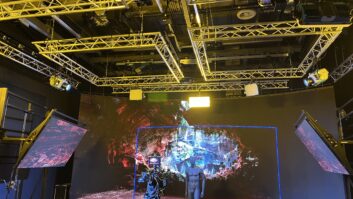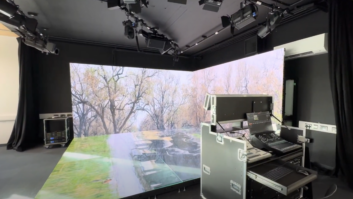
While LCD remains ahead, a number of factors such as smaller pixel pitches and build flexibility are helping the rise of LED technology, writes columnist Rob Lane.
Anybody who took the time to stroll around ISE last month (particularly Halls 11, 8 and 6) could not have failed to take note of the myriad LED displays in evidence – and not just as a preferred residential display tool. LED has historically been mainly confined to those halls whose focus was live events and rental, a niche, eye-candy display option. This year it was in evidence across almost all of the halls, offered for serious consideration in a multitude of corporate and retail environments.
Most notably, a huge 9.5m x 5m 8K LED videowall featuring on the Lang stand was built using 64 Leyard TW Series LED cabinets and featured a 54in diagonal and a 1.2mm pixel pitch with a resolution of 7680 x 4320 pixels. Also of interest was SiliconCore’s 0.95mm pixel pitch prototype with a 165in diagonal and AOTO’s 0.75mm M Series – and there were many other examples.
So no surprise then that while LCD continues to be the go-to choice for much of pro AV, LED is the rising star. Once the preserve of advertising, broadcast and stadium installations, it is increasingly being seen replacing projectors in auditoriums, and usurping LCD in retail environments and – more surprisingly, and perhaps less widespread – corporate reception areas and meeting rooms.
Reduced costs and shrinking pixel pitches (as low as 1.1mm – the same as plasma TVs when they first came to market in the late 1990s) for shorter viewing distances are helping the rise of LED. As these ultra-small pixel pitches become more affordable pro AV uses are broadening.
High brightness also has a big part to play, allowing LED to function well, both indoor and outdoor. Add to this the superior image conformity, vibrant colours, true black tones and long life spans, and it’s easy to see why integrators are keen to use LED over LCD for certain builds – despite the still higher prices.
The other major factor informing LED’s rise is its suitability for building videowalls. A lack of discernable bezels, build flexibility – LED walls can be built to virtually any size and aspect ratio – the relatively reduced weight and low power consumption all contribute to LED’s videowall desirability. And with the latest displays also curving and transparent it’s easy to see why videowalls will be increasingly LED-based going forward and why LED is the emerging technology of choice for building large, bespoke digital canvasses.
LCD still leads
However, as attractive a prospect as LED is, costs need to come down considerably before the technology completely usurps its more affordable and popular LCD cousin. Indeed, further reduction in pixel pitches would also be desirable and help to increase market share. For now – despite the upsurge in popularity for LED, particularly for videowalls – LCD remains the default single display of choice.
One of the reasons for this is the trend towards integrated large-format displays – still the preserve of LCD. For those demanding a large, single screen for a boardroom or meeting space there’s currently no LED product available that’s in the same price bracket, and it’s quicker and easier to buy and install an LCD.
In addition, the major professional LCD display manufacturers now all offer products with built-in computer functionality (System on Chip or SoC), with many offering it as standard – for a keener price, of course, than the equivalent LED/SoC offerings. There are obvious cost savings to not having to marry displays to discrete media players, and there are functional benefits too.
However, although LCD remains, for the time being, the one-stop, SoC-integrated option for integrators, most wouldn’t yet consider SoC solutions for driving 4K videowalls or LED canvasses. This is because the processing power of SoC isn’t always powerful enough to provide the ‘intelligence’ required to run larger display groupings, meaning that – for LED at least –media players still have a role to play.
This further explains why larger, cheaper SoC-integrated LCD displays are preferred for one-off big screen solutions, while LED is the growing standard for walls. But with SoC LEDs growing in availability, and costs set to come down – particularly over the next 18 months or so – LED will surely begin to replace LCD for one-screen solutions also.
The arrival of Samsung’s 1.5mm pixel pitch SMART LED range, featuring a variation on SoC, could possibly be a game-changer. Announced at last year’s InfoComm and set to make its UK debut as a demo unit in UK distributor PSCo’s reading showroom, the range is exciting integrators with its embedded S-Box (Signal Box) housing the display’s ‘MagicInfo’ CMS and media player.
A lot of things still have to fall into place to enable LED to completely replace LCD across the various pro-AV sectors. Cost, lead times, familiarity with the tech, like-for-like replacements with embedded media players, perceived reliability – these factors all have a part to play. But as one industry professional said to me, LED also needs to be demystified in the minds of end users and, to a lesser extent, integrators, before it can truly become the number one display choice.







